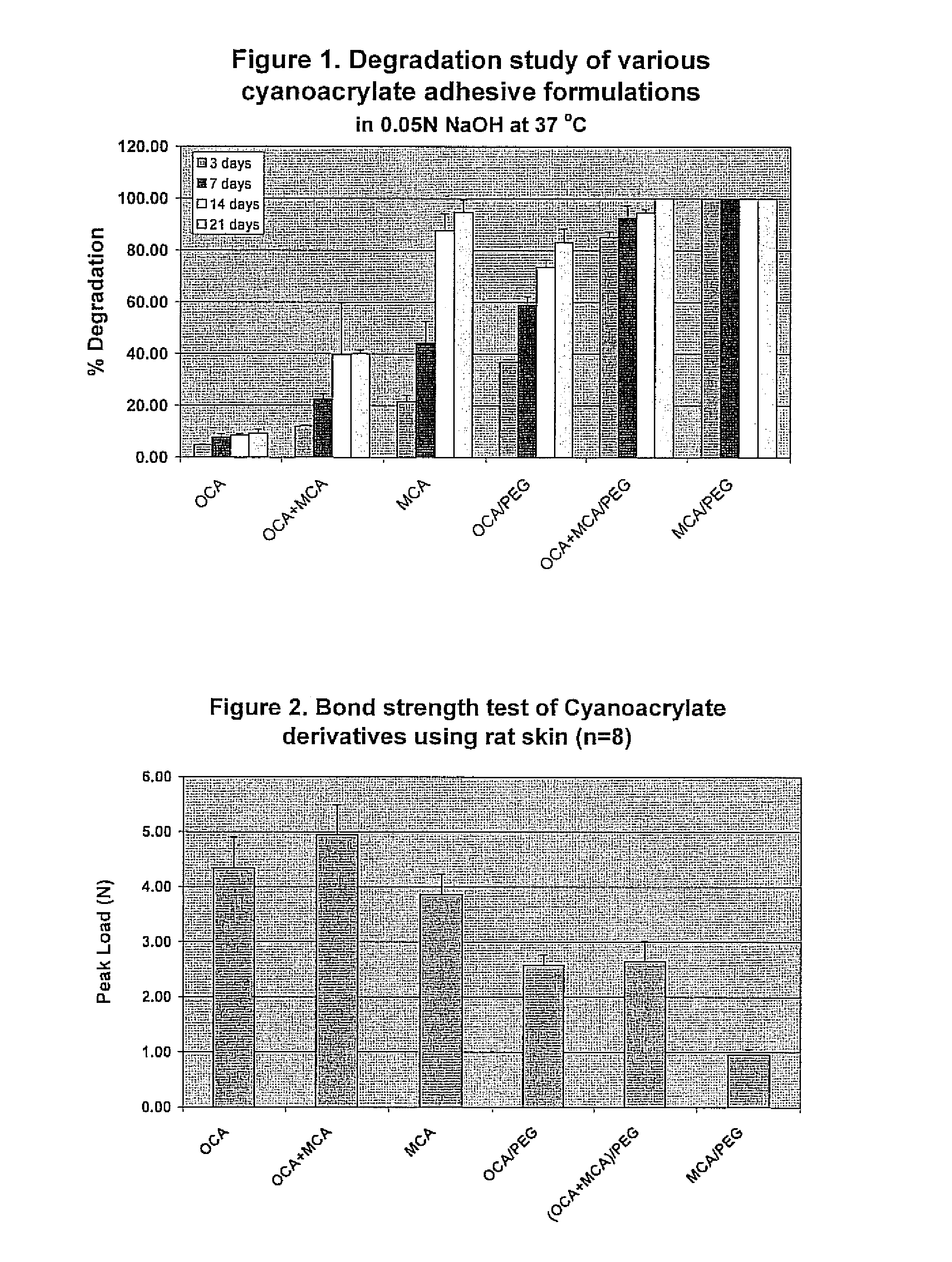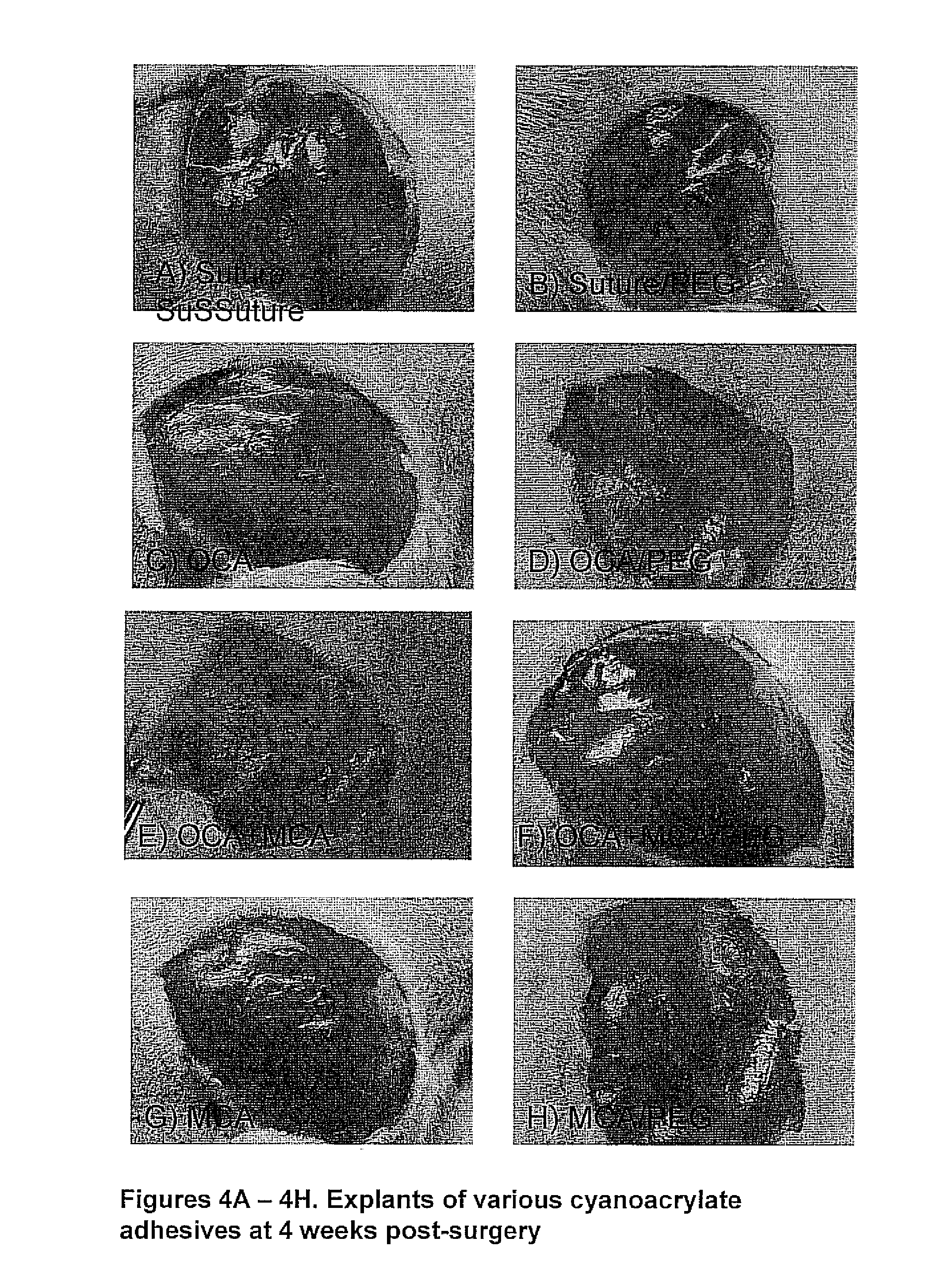Cyanoacrylate tissue adhesives
a technology of cyanoacrylate and tissue adhesive, which is applied in the direction of powder delivery, microcapsules, drug compositions, etc., can solve the problems of significant tissue toxicity, system would not work with drugs, and significant tissue toxicity, so as to prevent infection in wounds, accelerate the degradation of cyanoacrylate tissue adhesive, and accelerate the hydrolytic degradation
- Summary
- Abstract
- Description
- Claims
- Application Information
AI Technical Summary
Benefits of technology
Problems solved by technology
Method used
Image
Examples
example 1
Experimental Methods and Results
[0061]A series of experiments have been performed to evaluate the efficacy of cyanoacrylate adhesive formulations incorporating PEG. Throughout all experiments, PEG (MW=600) was added to cyanoacrylates at a 85:15 (v / v Cyanoacrylate / PEG) ratio. Three cyanoacrylate compositions were used: octylcyanoacrylate (OCA), a 50:50 mixture of octylcyanoacrylate and methoxyisopropylcyanoacrylate (OCA:MCA) and methoxyisopropylcyanoacrylate (MCA). Pure cyanoacrylate formulations were used throughout as controls for comparison to experimental formulations containing PEG.
1. In Vitro Degradation Study
[0062]In vitro accelerated degradation studies have been performed to evaluate the degradation rate of various cyanoacrylate adhesives formulated with PEG and without PEG. 20 μl of cyanoacrylate (CA) derivatives and CA derivatives / PEG (MW=600) formulations were spread as a thin layer on the glass microscope slides and allowed to cure overnight at room temperature. The resu...
example 2
Preparation of Drug-Loaded poly(butylcyanoacrylate) (PBCA) Particles
A. Polymyxin B-Loaded PBCA Nanoparticles
[0072]Polymyxin B-loaded polybutylcyanoacrylate (PBCA) particles were prepared by an anionic polymerization method (FIG. 11). Various amounts of polymyxin B were dissolved in various acidic polymerization medium containing different non-ionic surfactants and then various amount of butylcyanoacrylate were slowly added into the polymyxin B-containing polymerization medium under vigorous stirring. The polymerization of the monomer was allowed for four hours at room temperature under vigorous stirring to complete polymerization. When the polymerization was completed, the milky suspension was neutralized by 1N NaOH and then freeze-dried in a lyophilizer. The dried nanoparticles were resuspended in 10 ml distilled water and centrifuged at 15,000 rpm (Beckman centrifuge, JA 17 rotor, Beckman, USA) for an hour at 4° C. and the process was repeated two times to completely remove free d...
PUM
| Property | Measurement | Unit |
|---|---|---|
| width | aaaaa | aaaaa |
| width | aaaaa | aaaaa |
| depth | aaaaa | aaaaa |
Abstract
Description
Claims
Application Information
 Login to View More
Login to View More - R&D
- Intellectual Property
- Life Sciences
- Materials
- Tech Scout
- Unparalleled Data Quality
- Higher Quality Content
- 60% Fewer Hallucinations
Browse by: Latest US Patents, China's latest patents, Technical Efficacy Thesaurus, Application Domain, Technology Topic, Popular Technical Reports.
© 2025 PatSnap. All rights reserved.Legal|Privacy policy|Modern Slavery Act Transparency Statement|Sitemap|About US| Contact US: help@patsnap.com



